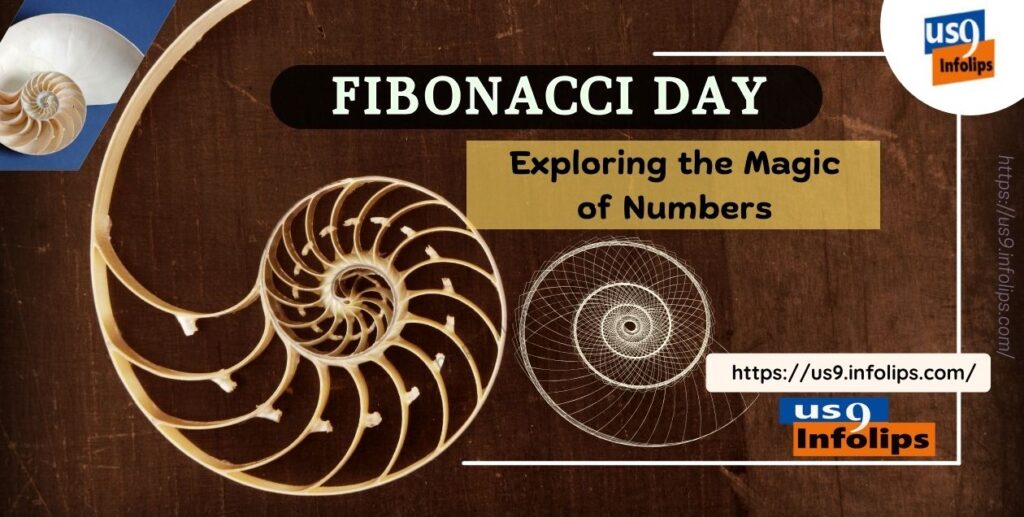Fibonacci Day: Exploring the Magic of Numbers
Fibonacci Day: Exploring the Magic of Numbers
Introduction
Fibonacci Day is observed annually on November 23rd (11/23), a date that reflects the famous Fibonacci sequence (1, 1, 2, 3). This day honors Leonardo of Pisa, popularly known as Fibonacci, whose mathematical discoveries have had a lasting impact on various fields. Here’s a detailed exploration of this unique celebration:
Table of Contents
1. Why November 23rd?
Fibonacci Day falls on 11/23, representing the beginning of the Fibonacci sequence: 1, 1, 2, 3. This sequence is a series of numbers where each number is the sum of the two preceding ones. It’s a simple yet profound pattern found in nature, art, and science.
2. Who Was Fibonacci?
Leonardo of Pisa, later called Fibonacci, was a 13th-century Italian mathematician. Born around 1170 in Pisa, he introduced the Hindu-Arabic numeral system to Europe through his book Liber Abaci (The Book of Calculation).
3. The Birth of the Fibonacci Sequence
Although the sequence existed in Indian mathematics, Fibonacci popularized it in Europe. He introduced it through a problem involving rabbit breeding, demonstrating how numbers grow in a predictable way over time.
4. When Did Fibonacci Day Begin?
While the sequence has been admired for centuries, Fibonacci Day is a modern observance. Mathematicians, educators, and enthusiasts started recognizing it to promote the beauty of mathematics in everyday life.
5. Nature’s Love for Fibonacci
The Fibonacci sequence appears in sunflower spirals, pinecones, shells, and the arrangement of leaves on plants. It showcases how numbers can help us understand patterns in nature, making this day a tribute to nature’s mathematical harmony.
6. Fibonacci in Art and Architecture
The sequence and its related concept, the Golden Ratio, are key to aesthetics. They’ve influenced art, from Leonardo da Vinci’s Vitruvian Man to modern designs, and architecture, such as the Parthenon and the Great Pyramid of Giza.
7. Educational Significance
Fibonacci Day provides a fun way to introduce students to mathematics. Schools and colleges often celebrate with activities like exploring nature’s patterns, solving puzzles, and creating Fibonacci-based art.
8. A Global Celebration of Math
Around the world, math enthusiasts organize events like workshops, lectures, and online challenges on Fibonacci Day. The goal is to foster an appreciation for numbers and their real-world applications.
9. The Role of Modern Technology
Today, Fibonacci’s principles are applied in computer algorithms, stock market analysis, and data science. This shows how his work continues to influence cutting-edge technologies.
Spreading Mathematical Joy
Fibonacci Day isn’t just for mathematicians; it’s for everyone. Whether you’re observing the sequence in nature, learning about its applications, or solving Fibonacci puzzles, this day reminds us that math is both practical and beautiful.
A Day to Celebrate Numbers
Fibonacci Day is a reminder of the magic hidden in numbers. It bridges the ancient and modern worlds, showcasing how something as simple as a number sequence can explain the complexity of life. So, on November 23rd, take a moment to marvel at the wonders of Fibonacci’s legacy!
Objectives of Fibonacci Day
- To celebrate the legacy of Fibonacci and his contributions to mathematics.
- To promote the understanding of the Fibonacci sequence in nature and science.
- To spark interest in mathematics through fun and engaging activities.
- To demonstrate the real-world applications of the Fibonacci sequence.
- To connect the sequence to art, architecture, and design.
- To encourage educators to introduce Fibonacci concepts in classrooms.
- To explore the relationship between Fibonacci numbers and the Golden Ratio.
- To inspire curiosity about mathematical patterns in everyday life.
- To honor the role of numbers in shaping human progress.
Facts About Fibonacci Day
- Fibonacci Day is celebrated on November 23rd, matching the sequence 1, 1, 2, 3.
- It honors Leonardo Fibonacci, who introduced the sequence to Europe.
- The Fibonacci sequence begins with 0 and 1, with each subsequent number being the sum of the two before it.
- The sequence appears in nature, such as in sunflower spirals and seashells.
- The Golden Ratio is closely related to Fibonacci numbers.
- Fibonacci introduced the Hindu-Arabic numeral system to Europe.
- The sequence has applications in stock market analysis.
- Fibonacci numbers are used in computer algorithms.
- The day is a favorite among math enthusiasts and educators.
Interesting Unknown Facts
- Fibonacci’s real name was Leonardo of Pisa; “Fibonacci” means “son of Bonacci.”
- He learned about the sequence during his travels in North Africa.
- The sequence was used in Indian mathematics centuries before Fibonacci’s time.
- It helps model population growth in biology.
- Fibonacci numbers are linked to efficient packing in logistics.
- Honeybee family trees follow the Fibonacci sequence.
- The sequence is used in digital image compression.
- It inspired music compositions like Debussy’s Reflets dans l’eau.
- Fibonacci’s work helped replace Roman numerals with the modern numeral system.
Controversies About Fibonacci Day
- Fibonacci didn’t invent the sequence, leading to debates about crediting him.
- Some argue the day overemphasizes math while neglecting Fibonacci’s other contributions.
- Misinterpretations of the Golden Ratio’s link to beauty create confusion.
- Claims about Fibonacci patterns in nature are sometimes exaggerated.
- Critics question the sequence’s practical value beyond theoretical math.
- The day is viewed by some as overly niche and inaccessible.
- Debates arise about focusing on Fibonacci over other mathematicians.
- Fibonacci’s contributions to business math are often overlooked.
- Controversy exists about whether the sequence is universally significant.
Conclusion
Fibonacci Day reminds us of the incredible patterns that shape our world. It’s a celebration of numbers, nature, and human ingenuity. By exploring the Fibonacci sequence, we connect with a timeless mathematical wonder that bridges the ancient and modern worlds.
FAQs About Fibonacci Day
- What is Fibonacci Day?
Fibonacci Day is celebrated on November 23rd to honor Leonardo Fibonacci and the sequence he popularized. - Why is it celebrated on November 23rd?
The date, 11/23, represents the beginning of the Fibonacci sequence: 1, 1, 2, 3. - Who was Fibonacci?
Fibonacci was an Italian mathematician known for introducing the Fibonacci sequence to Europe. - What is the Fibonacci sequence?
It’s a series where each number is the sum of the two preceding numbers. - Where can we see Fibonacci patterns in nature?
In sunflowers, pinecones, seashells, and the arrangement of leaves on plants. - How is Fibonacci Day celebrated?
Through math activities, educational workshops, and exploring Fibonacci’s applications. - What is the Golden Ratio?
A mathematical concept closely linked to Fibonacci numbers, symbolizing ideal proportions. - Did Fibonacci invent the sequence?
No, it existed earlier in Indian mathematics, but he popularized it in Europe. - What is the significance of Fibonacci in modern times?
Fibonacci numbers are used in computer algorithms, art, and stock market analysis.
Follow us for more captivating articles and stay connected to explore the world. Let’s embrace the power of communication and understanding.
Disclaimer: The views in this article are given with the help of information available on the net. Readers are encouraged to conduct their own research before making any decisions. The publisher disclaims any liability for any loss or damage caused directly or indirectly.

Related topics:
1. Perfect World Travel Guide
2. 9 Most Popular EV Cars in the USA
3. 9 Best Things About Apple TV 4K – Third Generation
4. Think before You Renew Amazon Prime
5. Jimmy Carter: A Great Legacy
6. Memorial Day: Honoring the Sacrifice, Celebrating Freedom
School Site :
For English grammar and lot more : Smart School Infolips
Marathi Poems: Marathi Rang












